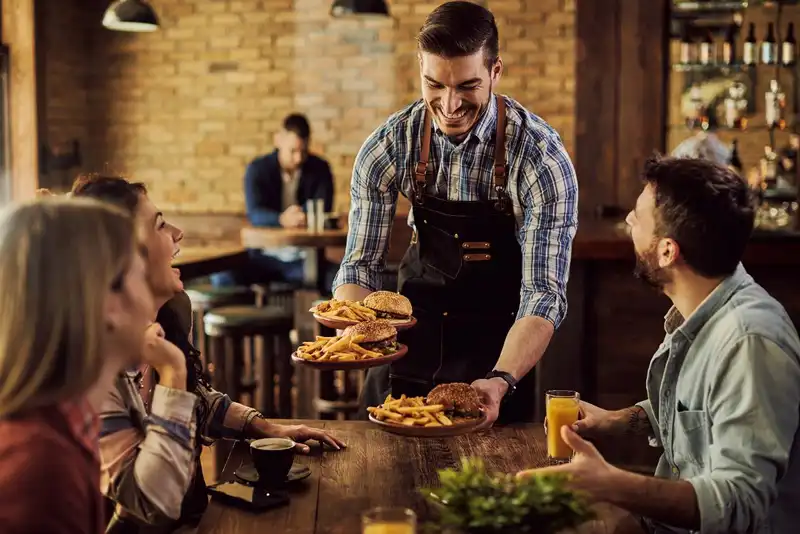How can restaurants use POS data to track customer behavior?
Restaurants can use POS data to track customer behavior by analyzing order history, frequency, item preferences, and purchase times. This helps identify trends, segment customers by type, and make informed decisions on menus, promotions, and staffing strategies.
Understanding the 6 Key Types of Consumers in the Restaurant Industry
Overview
Running a restaurant means serving many kinds of customers, each with different tastes and reasons for visiting. Some come for quick meals, others want healthy options, and some look for a special experience. Knowing who your customers are helps you make better choices about your menu, prices, and how you talk to them.
Research shows that restaurants that understand their customers well can increase repeat visits by up to 20%. That means happy customers come back more often, which helps your business grow. But figuring out who your customers are can feel tricky.
The good news is, you don't have to guess. Your restaurant's data - like what people order, how often they come, and what deals they use - can tell you a lot. You can use simple tools like your point-of-sale (POS) system or customer surveys to find patterns in how different types of people behave.
The Value Seeker

One of the most common types of restaurant customers is the Value Seeker. These diners are careful about how much they spend and want to feel like they are getting a good deal. They are drawn to promotions, combo meals, discounts, and specials. For them, the price is often just as important as the food itself.
You can identify Value Seekers by looking at your sales data. If a customer regularly uses coupons, buys items during happy hours, or picks value combos, they likely belong to this group. According to a study by the National Restaurant Association, about 60% of consumers say they are influenced by promotions when deciding where to eat. That shows just how important this group can be.
To spot Value Seekers using your POS system, check how often discounts or special offers are redeemed. You may also see a lower average check size per visit compared to other customers. If you use a loyalty program, see which members are more likely to use rewards or discounts.
Understanding Value Seekers helps you plan your menu and marketing better. Offering targeted deals that don't hurt your profit margin can keep these customers coming back regularly. But it's important to balance discounts with your restaurant's brand and not rely too heavily on price cuts alone.
By recognizing Value Seekers through data, you'll know when to offer promotions and how to attract customers who care about a good deal without losing sight of quality.
The Convenience-Driven Diner
The Convenience-Driven Diner is all about speed and ease. These customers want a smooth, no-hassle experience - whether they're grabbing lunch on a break, picking up dinner for the family, or ordering from their phones. They value clear menus, fast service, and the ability to order and pay quickly. Many of them rely on mobile ordering, delivery apps, or drive-thru options when available.
This type of diner is becoming more common, especially with younger generations. In fact, a recent report by Deloitte found that 64% of consumers prefer to order digitally whenever possible. This shift in behavior has made convenience a key factor in dining decisions.
To identify Convenience-Driven Diners, take a look at your POS and ordering data. Frequent mobile orders, high takeout or delivery volumes, and repeat purchases of the same items are strong indicators. These customers often visit during peak times - like lunch or early evening - and tend to spend less time dining in.
You can also learn from feedback surveys. If customers mention speed, ease of ordering, or frustration with wait times, they're likely part of this group. Watching table turnover rates and average service time also helps you spot patterns.
To serve these diners well, make sure your ordering process - online and in-person - is as simple as possible. Keep popular items easy to find, streamline your pickup process, and consider offering "grab-and-go" options.
The Health-Conscious Eater
The Health-Conscious Eater is a growing group of customers who care deeply about what goes into their food. These diners look for fresh ingredients, balanced meals, and options that align with their personal health goals. Whether it's low-carb, gluten-free, plant-based, or organic, these guests want food that makes them feel good - both physically and ethically.
This isn't just a niche trend. Studies show that over 50% of consumers say they're more likely to visit a restaurant that offers healthy menu options. As awareness about wellness grows, so does the demand for meals that support a healthy lifestyle.
You can identify Health-Conscious Eaters by looking at your menu data. These customers often choose items labeled as light, fresh, or clean. They may consistently order salads, grilled proteins, smoothies, or substitute sides like fruit instead of fries. You may also notice that they ask about ingredients, allergens, or nutritional details before placing an order.
Your POS system can help you track sales of health-focused items. You might also find insights through online ordering platforms where customers take more time to explore menu descriptions. If your website includes nutrition info, monitor page views to see which items get the most attention.
To support this group, consider keeping a few well-labeled healthy options on your menu and making ingredient details easy to find. Staff training is also key - employees should be able to answer basic nutrition or allergen questions with confidence.
The Brand Loyalist

The Brand Loyalist is the kind of customer every restaurant hopes to have. These diners keep coming back - not just for the food, but because they feel a connection to your brand. Whether it's your unique vibe, your consistent quality, or your friendly service, something about your restaurant has earned their trust.
Unlike deal-seekers, Brand Loyalists aren't just looking for the lowest price. They're looking for a reliable, enjoyable experience. A survey by Yotpo found that 36.5% of consumers say they're loyal to brands because they offer a consistently good experience. For restaurants, this can translate into frequent visits, word-of-mouth referrals, and higher average spending over time.
You can identify Brand Loyalists through repeat purchase patterns. Look for guests who visit weekly or monthly, order the same items, or participate actively in your loyalty program. POS data can reveal which customers have the highest lifetime value, while loyalty platforms can track points earned, rewards used, and visit frequency.
Another sign of loyalty is online engagement. Are they leaving positive reviews? Following you on social media? Opening your emails? All of these behaviors show a deeper emotional connection.
To nurture Brand Loyalists, focus on consistency. Make sure they get the same great food and service every time. Offer rewards that match their habits - like free items they actually order - and thank them for their loyalty, even with something as simple as a personalized message.
The Experience Seeker
For the Experience Seeker, going out to eat is about more than just the food. These customers are looking for an emotional connection, a sense of enjoyment, or a memorable moment. Whether it's a cozy atmosphere, unique decor, friendly service, or live entertainment, they want to feel something when they dine out.
Experience Seekers often dine in rather than take out. They're the ones celebrating birthdays, going on dinner dates, or meeting up with friends. According to industry research, nearly 45% of consumers say the overall dining experience influences their choice of restaurant as much as the food does. That means ambiance, service, and vibe play a huge role in where these customers choose to go.
You can identify Experience Seekers by their behavior. Look at table turnover data - these customers tend to stay longer. They may also order appetizers, desserts, or drinks, making their average ticket size higher. They're more likely to dine during weekends or evenings and may request seating preferences like patios or booths.
Feedback surveys and online reviews often reflect their priorities. If they mention the atmosphere, music, or how the staff made them feel, you're likely hearing from an Experience Seeker. You can also watch for customers who interact with staff or ask about the story behind the food or restaurant concept.
To keep these guests coming back, focus on delivering great service and creating a welcoming, well-designed space. Even small touches - like personalized greetings or special plating - can go a long way in creating the emotional connection they're looking for.
The Experimental Explorer
The Experimental Explorer is the customer who's always looking for something new. They love to try unfamiliar dishes, explore seasonal specials, and sample bold or trendy ingredients. For them, dining out is a chance to discover new tastes, cultures, and food experiences. These customers are adventurous, curious, and often the first to try your latest menu item.
This group is especially common among younger diners. According to a recent survey by Technomic, 66% of Gen Z consumers say they enjoy trying new foods regularly, and that curiosity directly influences their dining choices. If your restaurant offers rotating specials or limited-time items, these are the customers most likely to order them.
To identify Experimental Explorers, look at ordering patterns. Are there guests who frequently try new menu items or rarely repeat the same order? POS data can help you see who responds to your limited-time offers (LTOs), daily specials, or themed nights. These customers may also engage more on social media - liking posts about new dishes or commenting on food photos.
Surveys and online reviews often give clues as well. If guests mention words like "creative," "unique," or "different," they're likely part of this group. They may also ask your staff for recommendations or express interest in where ingredients come from.
To attract and retain Experimental Explorers, keep your menu fresh. Offer seasonal items, spotlight global flavors, or create tasting events. These diners thrive on change - and if your restaurant keeps surprising them, they'll keep coming back for more.
Turning Consumer Knowledge Into Better Decisions
Understanding the different types of customers who walk into your restaurant isn't just interesting - it's incredibly useful. From the deal-loving Value Seeker to the adventurous Experimental Explorer, each group brings unique preferences, habits, and expectations. The more clearly you can identify these customer types, the easier it becomes to shape your menu, service, marketing, and even staffing in ways that meet their needs.
No restaurant serves only one type of guest. Most people fall into more than one category depending on the occasion. A Brand Loyalist might also be Health-Conscious. A Convenience-Driven Diner could be a Value Seeker during the workweek and an Experience Seeker on the weekend. That's why using real data - not just guesswork - is key.
Tools like your POS system, customer surveys, loyalty program data, and online ordering reports can help paint a clearer picture of your audience. Over time, patterns emerge, and decisions become less about what if and more about "what works."
Make Smarter, Data-Driven Moves with Altametrics
If you're ready to truly understand your customers and use that insight to improve sales, retention, and satisfaction, Altametrics can help. Their platform turns raw data into clear, actionable insights - so you can track trends, segment guests, and make informed choices that grow your business.
Learn how Altametrics can help you unlock the full value of your customer data by clicking "Schedule a Demo" below.
Get Started with Smart Data Capture
Optimize Your Marketing Efforts with Altametrics
Must-Read Content

5 Key Market Analytics Metrics Every Restaurant Owner Should Track

How to Do a Market Analysis for Quick Service Restaurants


Menu Engineering with Customer Behavior Analytics










